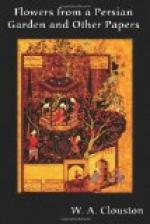[54] Captain R. C. Temple’s
Legends of the Panjab, vol. i,
p.
52 ff.; and “Four Legends of Raja Rasalu,”
by the
Rev.
C. Swynnerton, in the Folk-Lore Journal, 1883,
p.
141
ff.
* * * * *
The parrot is a very favourite character in Indian fictions, a circumstance originating, very possibly, in the Hindu belief in metempsychosis, or transmigration of souls after death into other animal forms, and also from the remarkable facility with which that bird imitates the human voice. In the Katha Sarit Sagara stories of wise parrots are of frequent occurrence; sometimes they figure as mere birds, but at other times as men who had been re-born in that form. In the third of the Twenty-Five Tales of a Demon (Sanskrit version), a king has a parrot, “possessed of god-like intellect, knowing all the shastras, having been born in that condition owing to a curse”; and his queen has a hen-maina “remarkable for knowledge.” They are placed in the same cage; and “one day the parrot became enamoured of the maina, and said to her: ’Marry me, fair one, as we sleep, perch, and feed in the same cage.’ But the maina answered him: ’I do not desire intimate union with a male, for all males are wicked and ungrateful.’ The parrot answered: ’It is not true that males are wicked, but females are wicked and cruel-hearted.’ And so a dispute arose between them. The two birds then made a bargain that, if the parrot won, he should have the maina for wife, and if the maina won, the parrot should be her slave, and they came before the prince to get a true judgment.” Each relates a story—the one to show that men are all wicked and ungrateful, the other, that women are wicked and cruel-hearted.




